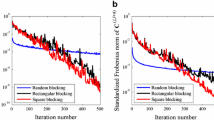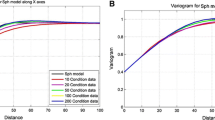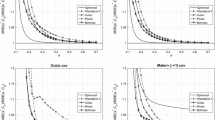Abstract
The conditional simulation of Gaussian random vectors is widely used in geostatistical applications to quantify uncertainty in regionalized phenomena that have been observed at finitely many sampling locations. Two iterative algorithms are presented to deal with such a simulation. The first one is a variation of the propagative version of the Gibbs sampler aimed at simulating the random vector without any conditioning data. The novelty of the presented algorithm stems from the introduction of a relaxation parameter that, if adequately chosen, allows quickening the rates of convergence and mixing of the sampler. The second algorithm is meant to convert the non-conditional simulation into a conditional one, based on the successive over-relaxation method. Again, a relaxation parameter allows quickening the convergence in distribution to the desired conditional random vector. Both algorithms are applicable in a very general setting and avoid the pivoting, inversion, square rooting or decomposition of the variance-covariance matrix of the vector to be simulated, thus reduce the computation costs and memory requirements with respect to other discrete geostatistical simulation approaches.





Similar content being viewed by others
References
Adler SL (1981) Over-relaxation method for the Monte Carlo evaluation of the partition function for multiquadratic actions. Phys Rev D 23(12):2901–2904
Alabert F (1987) The practice of fast conditional simulations through the LU decomposition of the covariance matrix. Math Geol 19(5):369–386
Alfaro M (1980) The random coin method: solution to the problem of the simulation of a random function in the plane. Math Geol 12(1):25–32
Armstrong M, Galli AG, Beucher H, Le Loc’h G, Renard D, Doligez B, Eschard R, Geffroy F (2011) Plurigaussian simulations in geosciences, 2nd edn. Springer, Berlin
Arroyo D, Emery X, Peláez M (2012) An enhanced Gibbs sampler algorithm for non-conditional simulation of Gaussian random vectors. Comput Geosci 46:138–148
Barone P, Frigessi A (1990) Improving stochastic relaxation for Gaussian random fields. Probab Eng Inf Sci 4(3):369–389
Box GEP, Jenkins GM (1976) Time series analysis: forecasting and control, Revised edn. Holden-Day, Oakland
Chellappa R, Jain A (1992) Markov random fields: theory and application. Academic Press, London
Chilès JP, Allard D (2005) Stochastic simulation of soil variations. In: Grunwald S (ed) Environmental soil-landscape modeling: geographic information technologies and pedometrics. CRC Press, Boca Raton, pp 289–305
Chilès JP, Delfiner P (2012) Geostatistics: modeling spatial uncertainty. Wiley, New York
Davis MW (1987) Production of conditional simulations via the LU triangular decomposition of the covariance matrix. Math Geol 19(2):91–98
Delfiner P, Chilès JP (1977) Conditional simulations: a new Monte Carlo approach to probabilistic evaluation of hydrocarbon in place. In: SPE paper 6985. Society of Petroleum Engineers
Delhomme JP (1979) Spatial variability and uncertainty in groundwater flow parameters: a geostatistical approach. Water Resour Res 15(2):269–280
Dietrich CR, Newsam GN (1993) A fast and exact method for multidimensional Gaussian stochastic simulations. Water Resour Res 29(8):2861–2869
Emery X (2009) The kriging update equations and their application to the selection of neighboring data. Comput Geosci 13(3):269–280
Emery X, Arroyo D (2018) On a continuous spectral algorithm for simulating non-stationary Gaussian random fields. Stoch Environ Res Risk Assess 32(5):905–919
Emery X, Lantuéjoul C (2006) TBSIM: a computer program for conditional simulation of three-dimensional Gaussian random fields via the turning bands method. Comput Geosci 32(10):1615–1628
Emery X, Peláez M (2011) Assessing the accuracy of sequential Gaussian simulation and cosimulation. Comput Geosci 15(4):673–689
Emery X, Arroyo D, Peláez M (2014) Simulating large Gaussian random vectors subject to inequality constraints by Gibbs sampling. Math Geosci 46(3):265–283
Emery X, Arroyo D, Porcu E (2016) An improved spectral turning-bands algorithm for simulating stationary vector Gaussian random fields. Stoch Environ Res Risk Assess 30(7):1863–1873
Freulon X (1994) Conditional simulation of a Gaussian random vector with nonlinear and/or noisy observations. In: Armstrong M, Dowd PA (eds) Geostatistical simulations. Kluwer Academic, Dordrecht, pp 57–71
Freulon X, de Fouquet C (1993) Conditioning a Gaussian model with inequalities. In: Soares A (ed) Geostatistics Tróia’92. Kluwer Academic, Dordrecht, pp 201–212
Galli A, Gao H (2001) Rate of convergence of the Gibbs sampler in the Gaussian case. Math Geol 33(6):653–677
Geweke J (1991) Efficient simulation from the multivariate normal and Student-t distributions subject to linear constraints and the evaluation of constraint probabilities. In: Keramidas EM, Kaufman SM (eds) Computing science and statistics: proceedings of the 23rd symposium on the interface. Interface Foundation of North America, Fairfax Station, pp 571–578
Green PJ, Han X (1992) Metropolis methods, Gaussian proposals and antithetic variables. In: Barone P, Frigessi A, Piccioni M (eds) Stochastic models, statistical methods, and algorithms in image analysis. Springer, New York, pp 142–164
Guyon X (1995) Random fields on a network: modeling, statistics, and applications. Springer, New York
Journel AG, Huijbregts CJ (1978) Mining geostatistics. Academic Press, London
Lantuéjoul C (2002) Geostatistical simulation: models and algorithms. Springer, Berlin
Lantuéjoul C, Desassis N (2012) Simulation of a Gaussian random vector: a propagative version of the Gibbs sampler. In: Presented at the 9th international geostatistics congress, Oslo. http://geostats2012.nr.no/pdfs/1747181.pdf. Accessed December 28, 2019
Marcotte D, Allard D (2018a) Half-tapering strategy for conditional simulation with large datasets. Stoch Environ Res Risk Assess 32(1):279–294
Marcotte D, Allard D (2018b) Gibbs sampling on large lattice with GMRF. Comput Geosci 111:190–199
Matérn B (1986) Spatial variation-stochastic models and their application to some problems in forest surveys and other sampling investigations. Springer, Berlin
Matheron G (1973) The intrinsic random functions and their applications. Adv Appl Probab 5(3):439–468
Neal RM (1998) Suppressing random walks in Markov chain Monte Carlo using ordered overrelaxation. In: Jordan MI (ed) Learning in graphical models. Kluwer Academic, Dordrecht, pp 205–225
Pakman A, Paninski L (2014) Exact Hamiltonian Monte Carlo for truncated multivariate Gaussians. J Comput Graph Stat 23(2):518–542
Pardo-Igúzquiza E, Chica-Olmo M (1993) The Fourier integral method: an efficient spectral method for simulation of random fields. Math Geol 25(2):177–217
Rue H (2001) Fast sampling of Gaussian Markov random fields. J R Stat Soc Ser B (Stat Methodol) 63(2):325–338
Safikhani M, Asghari O, Emery X (2017) Assessing the accuracy of sequential Gaussian simulation through statistical testing. Stoch Environ Res Risk Assess 31(2):523–533
Shinozuka M (1971) Simulation of multivariate and multidimensional random processes. J Acoust Soc Am 49(1B):357–367
Shive PN, Lowry T, Easley DH, Borgman LE (1990) Geostatistical simulation for geophysical applications—Part 2: geophysical modeling. Geophysics 55(11):1441–1446
Webster R, Oliver MA (2007) Geostatistics for environmental scientists, 2nd edn. Wiley, New York
Whitmer C (1984) Over-relaxation methods for Monte Carlo simulations of quadratic and multiquadratic actions. Phys Rev D 29(2):306–311
Wilhelm S, Manjunath BG (2010) tmvtnorm: a package for the truncated multivariate normal distribution. R J 2(1):25–29
Young DM (2003) Iterative solution of large linear systems. Dover Publications, New York
Acknowledgements
The authors acknowledge the funding by the National Agency for Research and Development of Chile, through Projects ANID/CONICYT FONDECYT INICIACIÓN EN INVESTIGACIÓN 11170529 (DA), ANID REC CONCURSO NACIONAL INSERCIÓN EN LA ACADEMIA, CONVOCATORIA 2016 PAI79160084 (DA), and ANID/CONICYT PIA AFB180004 (Advanced Mining Technology Center) (XE).
Author information
Authors and Affiliations
Corresponding author
Additional information
Publisher's Note
Springer Nature remains neutral with regard to jurisdictional claims in published maps and institutional affiliations.
Appendix 1
Appendix 1
Let X(0) = 0 and, for any positive integer k, X(k) be the random vector defined as per Eqs. (1) and (3). The sequence {X(k): k = 0, 1, 2, …} so obtained constitutes a Markov chain. It is easy to check that this chain is homogeneous (for k ≥ 1, the distribution of X(k) knowing X(k−1) does not depend on k), irreducible (because 1–ρ2 ≠ 0, any nonempty open set of \({\mathbb{R}}^n\) can be reached by the chain after finitely many iterations) and aperiodic.
Accordingly, to prove that the chain converges in probability to X, it remains to show that the distribution of X is invariant under the transition kernel of the chain (Lantuéjoul 2002). Suppose that X(k−1) is a Gaussian random vector with zero mean and variance-covariance matrix B. In such a case, the simple kriging error \(- {\mathbf{C}}_{JJ}^{ - 1} \,{\mathbf{C}}_{JI} \,{\mathbf{X}}_{I}^{(k - 1)} - {\mathbf{X}}_{J}^{(k - 1)}\) and SJ U(k) are two independent Gaussian random vectors with zero mean and variance-covariance matrix \({\varvec{\Upsigma }}_{J}\) and are independent of \({\mathbf{X}}_{I}^{(k - 1)}\). R(k), as defined by Eq. (3), is therefore a Gaussian random vector independent of \({\mathbf{X}}_{I}^{(k - 1)}\), with zero mean and variance-covariance matrix \({\varvec{\Upsigma }}_{J}\), irrespective of the choice of ρ. The proof by Arroyo et al. (2012) can be adapted to establish that, under these conditions, X(k) is a Gaussian random vector with zero mean and variance-covariance matrix B, Q.E.D.
Rights and permissions
About this article
Cite this article
Arroyo, D., Emery, X. Iterative algorithms for non-conditional and conditional simulation of Gaussian random vectors. Stoch Environ Res Risk Assess 34, 1523–1541 (2020). https://doi.org/10.1007/s00477-020-01875-0
Accepted:
Published:
Issue Date:
DOI: https://doi.org/10.1007/s00477-020-01875-0




